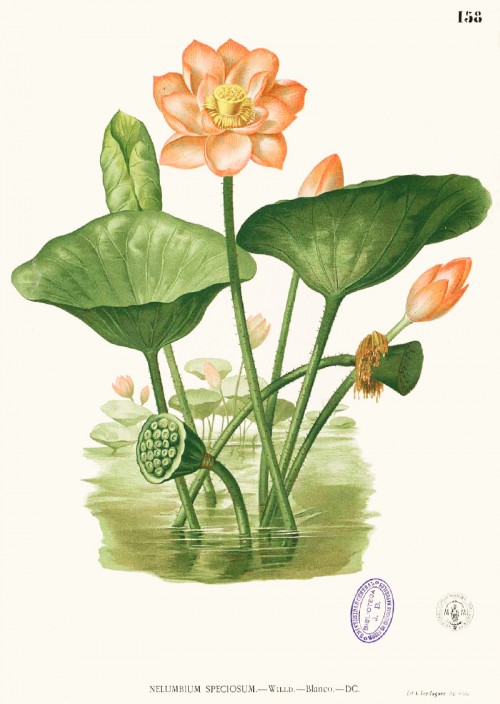Dies ist eine alte Version des Dokuments!
Nelumbo nucifera Gaertn. - syn.Nelumbo speciosa Willd.; Nymphaea nelumbo L. - Nelumbonaceae
lotus, (East) Indian lotus, sacred lotus, Indische Lotosblume, (Indischer) Lotus
„… sacred or Indian lotus, also known as the Rose of India and the sacred water lily of Hinduism and Buddhism. It is the national flower of India and Vietnam. Its roots and seeds are also used widely in Asian cooking… The flowers, seeds, young leaves, and „roots“ (rhizomes) are all edible… The stamens can be dried and made into a fragrant herbal tea called liánhuā cha (蓮花茶) in Chinese, or (particularly in Vietnam) used to impart a scent to tea leaves. This Vietnamese lotus tea is called trà sen, chè sen, or chè ướp sen. “ http://en.wikipedia.org/wiki/Nelumbo_nucifera
1,4-Dimethoxybenzene (93%) was found as main component in the aroma concentrate of dried lotus pollen, and it is also organoleptically clear the key aroma substance of Vietnamese lotus tea (600 lotus flowers/kg pan fired green tea).
[Yamanishi, Tei. „The aroma of various teas.“ Flavor of foods and beverages (Eds.: Charalambous, G., Inglett, GE), 1978, 324]
„A solvent extract of Nelumbo nucifera ‘Shinnyoren’ flowers was investigated by GC and GC/MS. Seventy compounds were identified with the major constituents being hydrocarbons representing more than 75% of the extract. 1,4-Dimethoxybenzene, 1,8-cineole, terpinen-4-ol and linalool were found to be indispensible in characterizing the scent of lotus flower.“
[The Scent of Lotus Flowers. Akihiko Omata, Katsuyuki Yomogida, Shoji Nakamura, Tadao Ohta, Yasuko Izawa, Satomi Watanabe, Journal of Essential Oil Research 01/1991; 3:221-227]
Main components of the scent (HS-GC/MS) were 1,4-dimethoxybenzene (45%), pentadecane (17%), sabinene (9.9%), hepta-x-ene (5%), 1,8-cineole (4.6%), and limonene (1.3%). A jasminoid note is generated by jasmone (0.1%) and methyl cis-(Z)-jasmonate (0.02%).
[Meaningful Scents around the World, R.Kaiser, 2006, 244]
„Different parts of N. nucifera, including the leaves, rhizomes, seeds and flowers, have been reported to have therapeutic potential in traditional medicine for the treatment of various diseases. Pharmacological activities of different extracts of rhizomes, seeds, leaves and flowers, and the compounds isolated from these extracts, have been demonstrated through numerous in-vitro and in-vivo test models. These include antioxidant, anti-inflammatory, antimicrobial, anti-arrhythmic, antipyretic, anti-ischaemic, anti-diabetic, hypoglycaemic, antidiarrhoeal, immunomodulatory and other activities. The responsible bioactive compounds belong to several chemical groups; mostly they are alkaloids (like dauricine, lotusine, nuciferine, liensinine, roemerine, neferine, armepavine), flavonoids (like kaempferol, quercetin, leucocyanidin, leucodelphinidin, catechin, isoquercitrin, astragalin), glycosides (nelumboroside A, nelumboroside B, isorhamnetin glycoside and isorhamnetin rutinoside), triterpenoid (like betulinic acid), vitamins and minerals. Thus, the pharmacological effects and various active ingredients of different parts of N. nucifera are well understood. This review highlights several pharmacological and phytochemical studies that have demonstrated the therapeutic potential of N. nucifera. “
[The sacred lotus (Nelumbo nucifera)– phytochemical and therapeutic profile. Mukherjee, P. K., Mukherjee, D., Maji, A. K., Rai, S. and Heinrich, M. (2009), Journal of Pharmacy and Pharmacology, 61: 407-422] http://onlinelibrary.wiley.com/doi/10.1211/jpp.61.04.0001/full

Blanco, M., Flora de Filipinas, t.158 (1875)
http://plantgenera.org/species.php?id_species=694346

